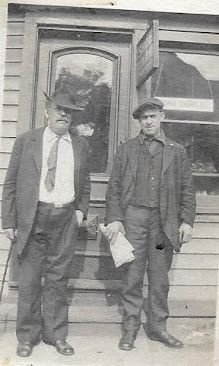To put it mildly, I've had the devil's own time tracing my McGarr ancestors, the family of my great-great-grandmother Maria on my father's side. Maria was born somewhere in Ireland and at some point, came to America. That was all I knew when I began. Maria's granddaughter, my grandmother, had given me the names of Maria's children, her husband, James O'Hara, (in fact it was O'Hora), and the obituary of one of her sons that gave Maria's maiden name as McGraw instead of McGarr. No wonder I struggled so in the beginning. This was before the days of Ancestry and online censuses, forcing me to travel to a nearby town to view those records; there I made my first breakthrough. In the censuses I found James and Maria along with all the children's names as Grandma had told me, but the surname was O'Hora, not O'Hara. All the census records had that spelling though, as did the newspapers I later found on microfilm from the NYS library, so apparently Grandma had preferred the O'Hara spelling which she herself had used before her marriage. Can't say I blame her.
It took a bit longer to straighten out Maria's maiden name. Finally a fellow researcher set me straight on that one and gave me a county, Kildare. Now I would surely find the townland of my McGarr clan! How foolish I was. It would be years before Irish church records came online and I was finally able to track the family down, but even that didn't prove easy. The McGarr family lived in one of those parishes whose boundry crossed county lines. I should have been looking for church records in the county of Wicklow, not in their home county of Kildare, and in the parish of Baltinglass to which their townland, Ballyraggan, (as I found in baptism records), belonged. Then there was the fact the simple surname McGarr confused a surprising number of people. In records it was variously spelled, McGah, Megar, Mager, McGare, etc... in only one instance did a church baptism record use the spelling "McGarr" and those search engines did not pick up the other versions. But at last, find them I did; Maria's parents, along with siblings I never knew she had.
Using US records, I had earlier found two sisters of Maria who like her, made their first home in America in Auburn, New York. Now, Irish baptim records revealed two more sisters and two brothers, the boys being the last children born in this family. Richard McGarr arrived in 1839, and his brother John in 1842. Then they vanished. Unlike the two new sisters, I've never found a single reference to either one of the boys after their baptisms, and therein lies my brick wall.
This complete lack of records concerning the pair makes me tend to believe they did not survive childhood. They would have been quite young when the potato blight hit Ireland, John only three and Richard six. Even though Kildare wasn't as badly affected as the western counties, hunger was not unknow and fever was rife in their area. It may have had some bearing that their mother Anne was known in her community as a healer, a tradition passed down in the family from mother to daughter. As late as 1899, her daughter Bridget Kinsella in New York was advertising her services in her hometown newspaper. Its conceivable individuals stricken with fever or other illnesses sought Anne's help in Ballyraggan, thereby spreading disease to her sons.
Another clue is the lease their father Daniel held for many years. In most cases, it would have gone to his eldest son, or at least to one of the sons upon his death, but it did not. Valuation Office records show that after Daniel died in 1875 it passed to Thomas Hughes, the husband of Daniel's youngest daughter Sarah.
I have my doubts I will ever discover the fate of Maria's two younger brothers. There are few early records available for Catholics, other than church records which in the 1800's didn't usually include death or burial information. Civil registration didn't start until 1864, obituaries for their class were unheard of, and tombstones almost unheard of. Did they contract one of the numerous diseases that plagued childhood, suffer from a deadly birth defect, meet with an accident? Did they leave Ireland for England or the United States? It seems if they came to America they would have settled near their sisters, at least initially, but no amount of searching has turned either of them up there or on the continent. I'm not ready to give up however, you never know what might be discovered in a new database. It took me well over a decade to find the county, (Queens), and parish, (Rathdowney), of great-great-grandfather James White; not until the advent of DNA, since the parish records for his era no longer exist. But if the data is out there, I will find it.





















